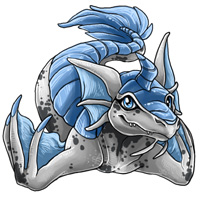Pet Facts



Quari Facts
|
A young quari's life starts out as an egg -- one among a small cluster -- on the ocean floor. The mother will lay these eggs in the darkest depths that she can possibly dive to in an attempt to shield the helpless eggs from predators. Caves are a preference, as this allows the mother to settle down and guard her eggs in safety. She will stay with the eggs for three weeks, going into a sort of semi-hibernation, which means she isn't required to leave often to forage for food. During the fourth week the mother stores up a supply of food for her youngsters for when they hatch a week later.
|
|
A newly hatched quari is its mother in miniature. Everything is fairly well developed except for their horn, which will slowly grow out to its full size in the next several months. The mother, for the next two months, will provide all the food and care her young need, and at the end of that period they instinctively begin to swim away. By this time they are nearly full grown and their horns, while not as fatal as an adult's, are still sharp forces to be reckoned with.
|
|
This is the time when a young quari will search for its gam. Its mother has already returned from her long seclusion to her own family and sometimes one or two of her babies will follow, but usually they will travel about for a short time until they find their own gam to join. Often groups of the same gender will temporarily stick together for protection, but these are usually broken up quickly due to quarreling and the lack of a mature leader; young quarian are usually hot tempered, energetic creatures who need a firm hand to stay in line.
|
|
Of course, even in a well led gam, this means that fights and competitions break out regularly amongst the more youthful members. Males will often "joust" with their horns, rushing each other as fast as their fins can propel them, trying to score a hit on their foe while using their back armor to protect their bodies. Females will sometimes engage in similar physical quarrels but usually they are less obvious, consisting more of passing hits and taunting, one trying to get a rise out of the other by using the claws on their fins and the long fans on their tails.
|
|
Eventually quarian do calm down, but all of them still retain a sense of competitiveness. Gams are generally fairly large -- the smallest one recorded numbered 15; the largest, 30 -- and group cohesion isn't terribly common; the leader of the gam is often a tough, scarred old quari who can keep the young ones in line and is respected by the inferior quarian. This keeps the peace.
|
|
Physically, quarian are built to live in very, very deep waters. Their bodies are both flexible and strong, able to withstand a great deal of pressure comfortably, and they do not rely much on eyesight -- in fact, strong light has been known to blind the incautious quari. Their eyes are big and highly sensitive to pick up the small amounts of light that sometimes manage to pierce the darkness of their home, but are considered secondary to their huge ears.
|
|
These ears work, of course, by using echolocation. A quari's voice is extremely high pitched and they are constantly "talking". At first this was thought to be the main mode of communication among the gam but it was quickly realized that this incessant noise was so the quari could see. The big, webbed flaps behind each ear -- which is a simple hole on the side of the head -- funnel in the sound, and a quari can tell what's around it judging by the pattern and changed pitch of the incoming sound.
|
|
The old findings, however, were half right; quarian do communicate using sound, just not the high pitched squeaks they use to figure out their surroundings. Quarian have a completely different "voice" for talking with the rest of their gam, and no one really knows what it sounds like because only a quari's ears seem to be able to pick it up! Highly sophisticated scientific instruments tell us this sound exists and the behavior of quarian also point to this conclusion, but it seems that these creatures have ears designed specifically to pick this sound up, because not only are humans unable to hear it, but neither are other species of Misticpets.
|
|
Quarian are also well designed for their preferred food source: pearls. Yes, those sharp, wicked looking teeth you see aren't for tearing flesh but for cracking and chewing pearls without breaking anything! A quari's jaw is immensely powerful, with very well developed muscles and small, stout and incredibly sharp teeth. This gives them an advantage in defense as well; few predators will take on a lone quari with the threat of that jaw, let alone an entire gam! Since pearls are often scarce, quarian often settle for munching on shells and rocks that are rich in the calcium that pearls are made of.
|
|
Despite their competitive and sometimes rough nature, quarian are quite creative and have come up with many ways to eat their beloved pearls. They'll crush them with stones, using their jaws and flippers as "hands", mix them with other tasty plants and coral, and a number of other things that would amaze most Misticans!
|
|
Seeing a quari on the surface of the ocean is extremely rare, as quarian do not like light and much prefer the deep waters. However, on cloudy days, a gam might get curious and come up to poke their noses into the air, or venture into shallow waters in search of food, so watch closely!
|
Go Back
